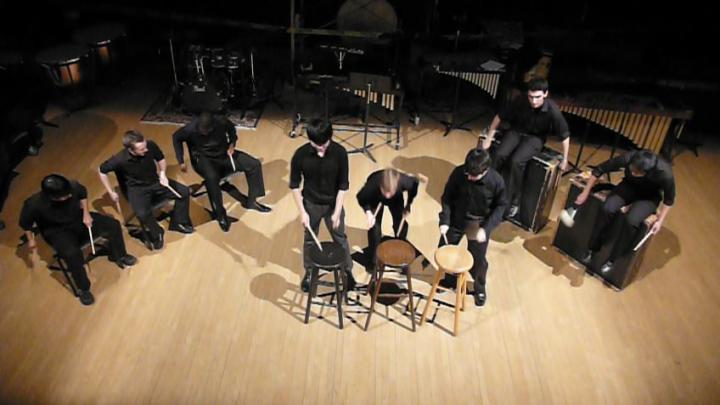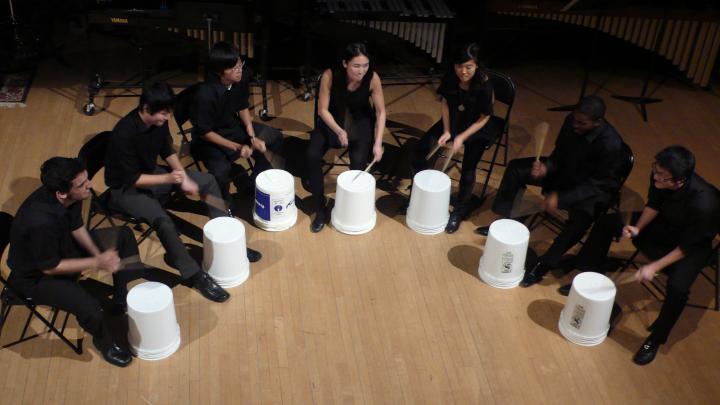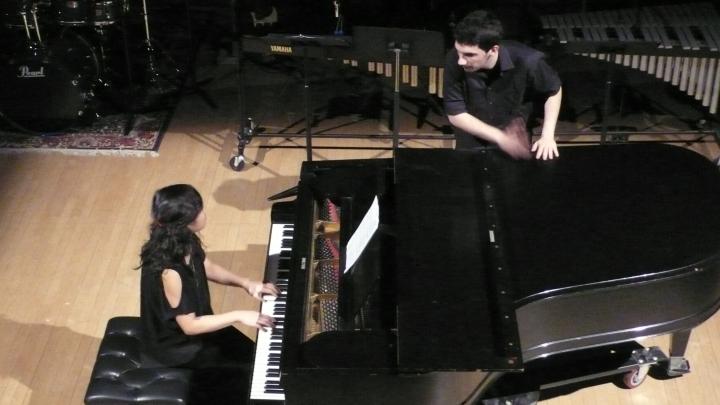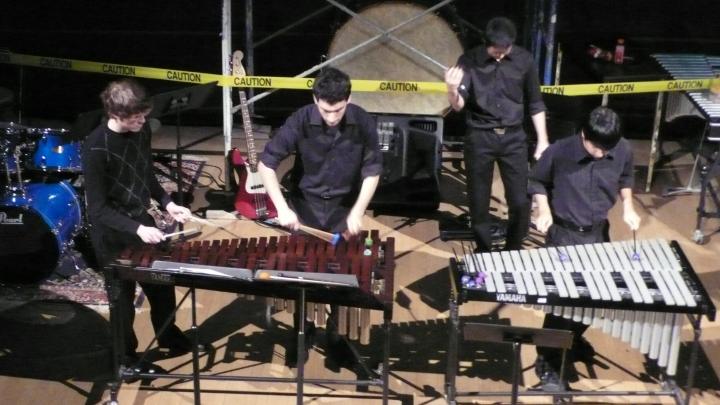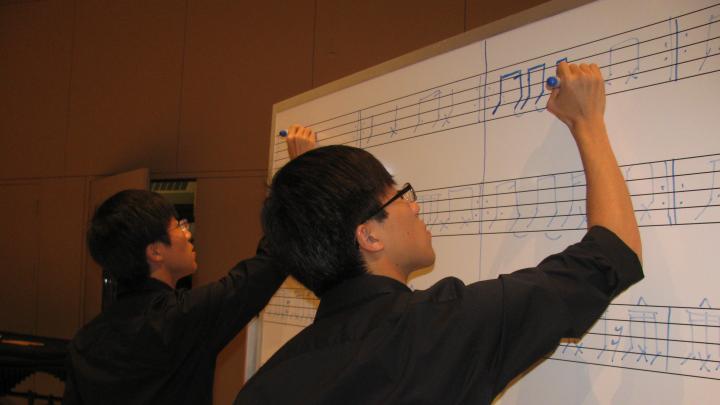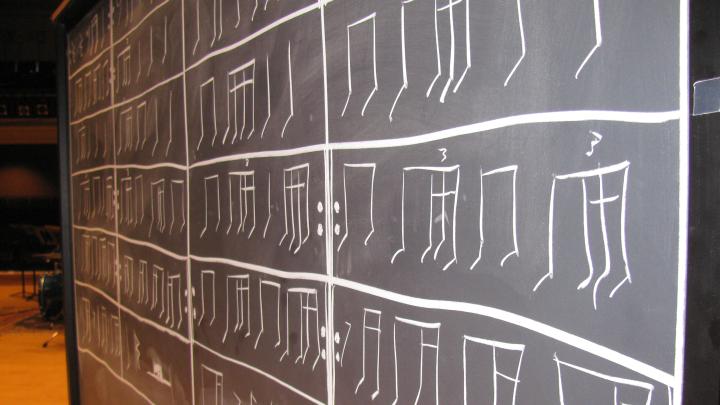It's impossible not to know when THUD (The Harvard Undergraduate Drummers group) is rehearsing.
Booming drums, tapping drumsticks, the falling-water roll of a xylophone, the piercing chime of a glockenspiel. Hands beating on music stands, singing and shouting voices, drumsticks on the floor, desks, chairs, doors, each other, anything. In short: cacophony. It's not always easy to tell when THUD is rehearsing actual pieces, as opposed to spontaneously beating out rhythms on anything and everything in sight.
Most members have been drumming for a long while: some played traditional percussion instruments growing up, and many were deeply involved with high-school marching bands. “My whole life has been spent drumming on whatever’s in front of me,” says former THUD director Ben Burns ’10. Several ensemble members cite the group as one of the reasons they chose Harvard.
Each semester, THUD’s concert features a mix of music played on traditional and nontraditional instruments: drums, xylophone, marimba, and chimes—but also chalkboards, bottles, brooms, bouncing balls, themselves. (The group’s reuse of materials earned it a slot as performers during the University’s “Green Carpet Awards,” which recognize affiliates’ contributions to environmental sustainability.) As Seungjun Kim ’13 puts it, “We find music in everyday objects.”
Or as his twin, Seungsoo Kim ’13, says more bluntly, “It’s us hitting things.”
The group is nothing if not playful: at a January rehearsal, they decided to write a piece with canes, for the graduating seniors (double entendre intended), and discussed pun-based ideas for pieces in their spring concert, themed “THUD Rock”: Rock-maninoff, Rock-y Balboa, The Rolling Stones. Amid this discussion, ensemble member Alex Amis ’15 said quietly, “This is the best organization on campus.”
Iguosadolo “Dolo” Nosamiefan ’14 is the official “THUD sweets distributor.” He showed up at a February rehearsal with a bag of jellybeans and a stack of newspapers. Already present: two large blocks of wood, a pebble shaker, a deck of cards. For the next few minutes, there was almost no talking, just sound: Hanna Choi ’12, one of the ensemble’s current directors, tapped rocks together. Seungsoo Kim opened and closed a pair of scissors, a light rasp of metal sliding past metal. There was the loud crack of a newspaper pulled suddenly taut; a breathy rustle if ruffled with a certain gentle rhythm and made to billow in its own wind. The crisp sound of paper tearing, scritch-scratch of sandpaper against itself. “When we decide to use a new instrument,” said Amis, “we basically hit it every which way and see what sounds it makes.”
Seven people stared intently at rock, paper, scissors. The task: compose something for the concert.
Of the 11 pieces in the spring concert, seven were THUD originals. Three were composed by Noam Hassenfeld ’12, a concentrator in the comparative study of religion and one of four current ensemble directors who together oversee the group’s creative direction, write and arrange music, organize rehearsals, and manage concert logistics. Hassenfeld relishes the creative freedom and the group’s sense of adventure and humor: “I write something, and I have an ensemble just waiting to play it. I can do basically anything.”
The group’s original compositions are commonly motivated by the question, “What if...?” Two years ago, Rupak Chakraborty ’10, another former director, composed a work featuring carpentry tools. The piece has since become THUD legend: screwdrivers, hammers, and saws beat out rhythms on nails and blocks of wood, and in the course of performing the piece, the group built a table out of wooden planks and boards. They then used the table in the next piece, which featured plates and silverware in a scene at a cafe.
It’s tricky to find a place for THUD in the intersection of 15 people’s busy lives. Participants have vastly different personalities and academic backgrounds; THUD is often their only intersection—a space that exists for a certain kind of music and creativity, and is strongly defined by it. The group traditionally rehearses in Lowell Lecture Hall from 10 p.m. to midnight on Mondays, in part because it's a time that no other group wants. Still, people are often late or absent entirely.
At a rehearsal just four hours before the spring concert on March 30, it was a race to the finish. Fran Lee ’15 came straight from the airport, after taking his oath of Canadian citizenship the day before. One of the THUD directors, Olumurejiwa “Mureji” Fatunde ’12, had turned in her senior thesis in biomedical engineering that afternoon, and when she walked into the room, she looked exhausted. With just hours to go, the group was still refining the pieces they would perform that evening. “We’re always coming up with new pieces, even up until the last minute,” says Seungjun Kim. “It always feels like everything’s in progress.” “Every single semester, it’s a miracle,” his brother says, with a sigh.
At 8 p.m.—showtime—group members entered the stage in Lowell Lecture Hall, one at a time, dressed in black. Hassenfeld growled their names into the microphone as the Chicago Bulls entrance song played and multicolored lights flashed. Then the show began. There were textured, elliptical rhythms from mallet instruments, the sharp rapping of snare drums, and the crash of cymbals. The seniors jousted with canes. Another piece used chalkboards and whiteboards, with beats tapped out with chalk and dry-erase markers. (“Music 101: Intro to Rhythm, Whiteboard for Twins” read the board.)
The “rock” puns reappeared in song names and the playful transitions between pieces—rock around the clock, between a rock and a hard place, rock and roll. Amis and Nosamiefan brought out a whole bucket of rocks. They placed them on the stage one at a time: “One rock, two rock…” all the way to 30 Rock (Lee and Matt Watson ’15 chimed in with the show’s theme song, played on marimba).
In the “Rock, Paper, Scissors” segment (see video at bottom of page), three group members—Charlotte Chang ’12 with rock, Choi with paper, and Nosamiefan with scissors—acted out a short, nonverbal battle among the three instruments. The musical call and response ended in a tie. “Shoot!” they exclaimed, in unison.
Soon there was just one piece left: “Cups”—a THUD tradition, the final selection at every concert. The basic concept is simple—a rhythm derived from a camp game that combines clapping and drumming on the table while maneuvering a bright-red, 16-ounce plastic cup (the kind perhaps more familiar to college students from games involving alcohol). The THUD version, composed of variations on this theme, is different every year. Four or five years ago, someone thought to hide a blue cup under the usual red one, opening the door to new visuals and elaborate variations. This year, the group added a move that mimics drinking out of the cup (see video at bottom of page).
Jason Armstrong ’03, a THUD member during its inaugural season in 1999, originated “Cups.” He now teaches music and math at Grove Hall Preparatory Charter School in Boston’s Dorchester neighborhood. To teach rhythm to his fifth-grade classes, he often uses concepts from THUD, like drumming on trash cans or buckets. He has stayed in contact with the group, and once arranged for his middle-school class to play a piece at a THUD concert.
As THUD evolves, “Cups” serves as a tie to the past and a kind of oral tradition. Hassenfeld even wrote a paper about the piece for a General Education course, “Culture and Belief 16: Performance, Tradition, and Cultural Studies: An Introduction to Folklore and Mythology.” An excerpt describes the work’s deeper meaning: “As both conscious and unconscious variations continue to take place, no one can predict in which direction the piece will be headed. One can be sure, however, that the piece will not remain stagnant, but will rather continue as a dynamic, constantly self-renewing tradition.”
Rock on.
